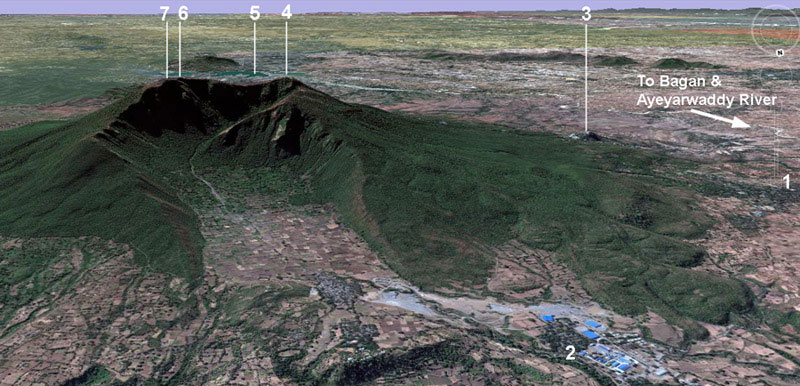|
|
National parks
Popa mountain park - Mandalay division

Extinct and exploded volcano Mt. Popa - google earth image
- Popa village
- Popa mountain village
- Popa taung kalat (volcanic cone with pagodas and spirint houses)
- Mt. Popa main peak or summit with radio/tv tower and a pagoda
- Kyat Mauk Taung dam lake
- Peak 2 with small Chedi
- Peak 3 with small Chedi (Hman Pya Taung)
 Popa mountain (extinct volcano) park is located in Kyaukpadaung township of Mandalay division.
It is only 67 km from 11th century Buddhist archaeological site of Bagan. The park covers 49.63 square miles area.
It was established in 1989.
Popa mountain (extinct volcano) park is located in Kyaukpadaung township of Mandalay division.
It is only 67 km from 11th century Buddhist archaeological site of Bagan. The park covers 49.63 square miles area.
It was established in 1989.
Access
Yangon via Pyay and Kyaukpadaung to Popa, 412 miles (659 km) by car.
Yangon via Meikhtila and Kyaukpadaung to Popa, 400 miles (640 km) by car.
Yangon via Nyaung U (near Bagan), 320 miles (512 km) by air and 37 miles (59 km) by car.
Objectives
To preserve the forest area of popa Mountain and to conserve the unique dry zone ecosystem and biodiversity with various plants and wildlife species.
To conserve the watersheds of near by reservoirs and dams including Kyetmauktaung Dam.
To ensure continuous flow of water supply to Kyaukpadaung and nearby villages from natural springs.
To conserve medicinal plants and climbers.
To preserve unique geological features and to conserve cultural and religious heritages.
To promote ecotourism.
Forest / vegetation types
 Forests include Than-Dahat forests,
low indaing forests,
upper mixed deciduous forests,
hill evergreen forests,
pine forests, and hill grassland.
Forests include Than-Dahat forests,
low indaing forests,
upper mixed deciduous forests,
hill evergreen forests,
pine forests, and hill grassland.
Wildlife
Monkey, barking deer, wild pig, jungle cat, wild dog and about 140 avifauna species inhabit the Popa area. The dusky leaf monkey is a scare animal and about 150 monkeys live in the Popa mountain park.
Medicinal plants and climbers
According to the collected data, about 40 medicinal plants and some climbers are growing in the Popa mountain park. These plants and climbers are being explored through field research works.
Conservation, development and research programmes
Conservation of natural forest
Enrichment planting with indigenous tree species.
Establishment of Popa Mountain Resorts, construction of mountain circuits and maintainance of golf course to facilitate recreation and promote ecotourism.
Conducting of research works on the conservation of flora and fauna.
Establishment of watershed Plantations.
Conservation and planting of medicinal plants and climbers.
Promoting, public awarness of environmental conservation.
Conducting of Socio-ecimomic surveys in nearby villages.
Implementation of buffer zone management.
Opportunities for study and recreation
Observing dry zone ecosystem, avifauna species and other wild animals.
Enjoyment of the natural beauty of Popa, Oasis of the Dry Zone.
Studying the naturally regenerated of sandalwood species.
Studying geological features and minerals from and extinct volcano which erupted 25,000 years ago.
|
Location map of parks
Khakaborazi national park
Indawgyi lake wildlife sanctuary
Chatthin wildlife sanctuary
Alaungdaw Kathapa national park
Maymyo botanical garden
Nat Ma Taung (Mt Victoria) national park
Popa mountain park
Inle lake wetland sanctuary
Shwesettaw wildlife sanctuary
Sein Ye forest camp
Moneyingyi wetland wildlife sanctuary
Myaing Hay Wun elephant camp
Hlawaga park
Yangon zoological garden
Meinmahla Kyun (island) wildlife sanctuary
|
|


